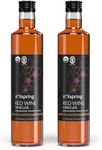Buying Guide for the Best Red Wine Vinegars
Choosing the right red wine vinegar can elevate your culinary creations, adding depth and complexity to your dishes. When selecting a red wine vinegar, it's important to consider several key specifications to ensure you pick the best fit for your needs. Understanding these specifications will help you make an informed decision and enhance your cooking experience.Acidity LevelAcidity level in red wine vinegar is a measure of its sourness and tanginess. This spec is important because it affects the flavor profile and how the vinegar interacts with other ingredients in your dish. Acidity levels typically range from 5% to 7%. Lower acidity (around 5%) is milder and suitable for delicate dishes like salads, while higher acidity (6-7%) provides a stronger punch, ideal for marinades and pickling. Choose the acidity level based on the intensity of flavor you desire in your recipes.
AgingAging refers to the amount of time the vinegar has been left to mature. This spec is important because aged vinegars tend to have a more complex and mellow flavor compared to younger ones. Vinegars aged for a few months are sharper and more acidic, while those aged for several years develop richer, smoother, and more nuanced flavors. If you prefer a robust and sophisticated taste, opt for an aged vinegar. For everyday use and simpler dishes, a younger vinegar will suffice.
Grape VarietyThe grape variety used to make the red wine vinegar influences its flavor and aroma. This spec is important because different grapes impart distinct characteristics to the vinegar. Common varieties include Cabernet Sauvignon, Merlot, and Pinot Noir. Cabernet Sauvignon vinegars are bold and full-bodied, Merlot vinegars are softer and fruitier, and Pinot Noir vinegars are delicate and aromatic. Choose a grape variety that complements the flavors of the dishes you frequently prepare.
OriginThe origin of the red wine vinegar can affect its quality and flavor profile. This spec is important because vinegars from different regions have unique characteristics based on local winemaking traditions and grape varieties. For example, vinegars from Italy or France are often highly regarded for their quality and depth of flavor. Consider the origin if you are looking for a specific taste or if you prefer vinegars from renowned wine-producing regions.
AdditivesAdditives in red wine vinegar can include preservatives, colorings, or flavor enhancers. This spec is important because additives can affect the purity and natural taste of the vinegar. Some people prefer vinegars without any additives for a more authentic and unadulterated flavor. If you are concerned about additives, look for labels that indicate 'all-natural' or 'organic' to ensure you are getting a product with minimal or no added substances.





















